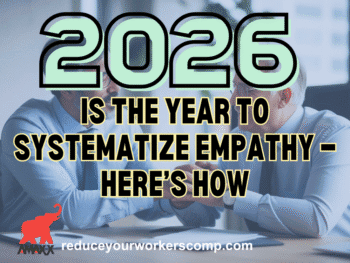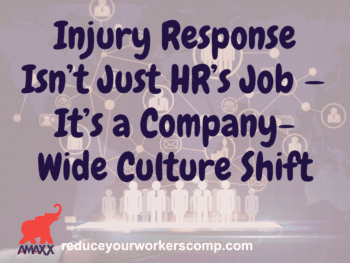A Procedure for Managing Pushback at the Organizational Level
Managing pushback from an organization level is about management dealing with pushback from a group of people resistant to participating in a company-wide workers’ comp management program.
Rule of Thumb: Do Not Assign Ownership to the Conflict, But Assign Ownership to Resolutions
A team approach is always best for dealing with pushback. When you are first approached by a group of disgruntled employees, gather and document their concerns and make sure they know ownership is not assigned to the problem, but to the remedy.
Tell them what they can expect in the future. There will probably be a series of meetings as part of ongoing conflict resolution. Explain there are some things within your control and other things not in your control. Tell them they can expect to receive an invitation to a series of meeting and to calendar these meetings as ‘we participate as a group in resolving our issues.”
The First Meeting
Send the invitation explaining it is a listening session where you attempt to capture concerns on a spreadsheet as a means of establishing and gaining consensus further down the road. Itemize issues by immediate solution, short/long-term solution and issues beyond your control. Tell them we are going to build consensus and resolution as meetings progress.
After the meeting, send a follow up email attaching the spreadsheet. Send an invitation to the next meeting. If you believe the meetings will be recurring, schedule them in advance so participants can plan to attend.
The Second Meeting
Tell invitees the second will be a confirmation and brainstorming session. Be honest with them. Reiterate how you’ve grouped concerns by immediate and short/long term and beyond your control. Using a projector put the matrix up on a screen to be seen by all members. Go through each concern, (immediate, long/short/term, and beyond your control) and confirm that these are the actual concerns.
Now elicit brainstorming ideas from members. You will be surprised at the ideas coming from the group. Type in solutions step-by-step, and as you do, begin to task members, assigning ownership of action items at this time. When they offer a suggestion, ask if they would be able to help with it. In this way, they become de facto involved with the workers’ comp initiative.
The Solution Matrix
Look for common threads among issues and remedial strategies. You may be able to sort by common threads, and group in this way. When possible group them, asking the group if this is acceptable. Matrix as you go along, so all members can see the working document.
End the meeting by reiterating tasks, and owners. Then follow up with the new matrix to accompany a reminder of the third meeting. If you can, put the matrix on a shared drive and send the location to participants. They can go in an update the matrix as new developments and solutions come to fruition.
The Third and Subsequent Meetings
By the third meeting, resolutions should be underway as evident on the matrix when you project it. Task owners will have gone in and posted the status, so now is a time of discussion of obstacles, and workarounds.
How to Criticize (Critique) Constructively
1. Allow employees to voice their concerns.
2. Listen carefully and repeat their concerns back to them.
3. Put concerns in writing word-for- word to emphasize they have been heard. Keep concerns neutral.
4. Meet consecutively to (a) capture additional concerns and reiterate; (b) confirm, find common threads to group; (c) task members with ownership of resolutions, and meet periodically until resolutions come to fruition.
5. Be very careful how you critique or criticize. Always lead with something positive, and couch your criticisms in a question, “Couldn’t we do something like this?,” giving an opportunity to answer you as an equal. Listen to what they say, and write it down, and try to find a place in the middle where you can come to an agreement.
6. Try to bring push back to a place where you both can ask, “What can we do to resolve this?” Again, it’s always a good idea to stay issue specific, and have participants write down their concerns and solutions to those concerns. If you all wish – keep them anonymous. Have participants throw them into a hat.
Heading off Pushback – a Proactive Approach
If you thinka bout it, by the time you are dealing with pushback, you are coming from a reactive stance. Wouldn’t it be nice to be proactive about pushback and head it off before it becomes an issue. Here is a way many large corporations are dealing with push back today:
Management has begun to build Employee Involvement team meetings into their annual performance measures. Before the kick off meeting, employees drop topics into a box in the cafeteria or department/units identify topics. You will find most suggestions come under the auspices of global concerns such as — cost reduction, safety, workers’ comp management, morale improvement, and everything else is a wild card topic.
Sponsor a half-day kick-off meeting for each department. Include coffee and donuts, and, if possible, have the meetings off site.. Have a table, easel, and chart paper and markers for each table.
Group employees into teams. The teams rotate, going from one table to another, suggesting solutions to the topics and the possibilities are written on charts stationed at each table.
By the end of the meeting, each team has brainstormed solutions for each topic. Then each topic and its possible solutions are matrixed to an Excel spreadsheet.
Invite employees to join involvement teams meeting or twice a month. At the first meeting, employees review all the solutions for their topic. Based on group response, some solutions are discarded and redundancies summarized.
Members take ownership of one or more of the solutions and research them. The matrix is kept on a shared drive where solution owners can input their research updates as they go along. (workersxzcompxzkit)
By the end of the year, many solutions are generated. Discarded solutions are those made as a team decision. No matter the reason, (solutions discarded due to cost or timing, or impossibility of implementation) it is a team decision.
Author Robert Elliott can be contacted at: Robert_Elliott@ReduceYourWorkersComp.com or 860-553-6604.
“FRAUD PREVENTION” PODCAST click here: http://www.workerscompkit.com/gallagher/mp3
By: Private investigator with 25 years experience.
TD Calculator: www.ReduceYourWorkersComp.com/transitional-duty-cost-calculator.php
WC Calculator: http://www.reduceyourworkerscomp.com/calculator.php
Do not use this information without independent verification. All state laws vary. You should consult with your insurance broker or agents about workers’ comp issues.
©2009 Amaxx Risk Solutions, Inc. All rights reserved under International Copyright Law. If you would like permission to reprint this material, contact Info@WorkersCompKit.com
















